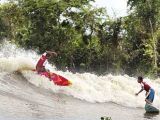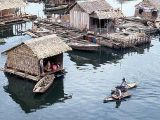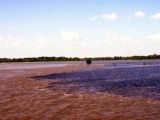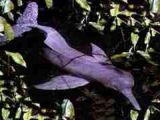This is the river of the superlatives. Nile is consensually considered the longest river on Earth, with 6,695 km in length, but some say the Amazon has this honor, with 6,800 km in length. Some researchers even state that Amazon is 7,100 km long. The problem is that nobody could tell where Amazon ends, due to its huge mouth. Anyway, Amazon's debit is 60 times bigger than that of the former: 200,000 cubic meters/second (of course, the largest in the world and 20 % of the freshwater volume penetrating the oceans).
If the Nile does not receive any affluent on its last 2,400 km, the Amazon picks up extremely powerful ones. In fact, the Amazon volume is that of Mississippi, Nile and Yangtze together. It forms a layer of freshwater into the Atlantic 200 km away from the river's mouth.
The navigable network of the Amazon is of 25,000 km (16,000 mi). Iquitos, in Peru, is considered a port at the Atlantic, because of the Amazon! There was even a natural canal, turned navigable by humans, linking Amazon to Orinoco, the second largest river in South America.
The river roots in a Peruvian glacial lake in the Andes, at 5,250 m, near Cailloma, at just 160 km (100 mi) off the Pacific coast. This portion of the Amazon is called Apurimac. In Brazil, it is called Solimoes before uniting with Rio Negro (near Manaus), but then, it changes its name to Amazon.
The color of the Amazon can change continuously, due to the color of the waters of its affluents. Rio Negro ("Black River") coming from the north disgorges water loaded with black forest soil; southern affluents bring crystalline water, filtered by sandy soils; western affluents bring light brown waters, due to the Andean rocks; other affluents are green. Where Rio Negro (with black water) flows into the muddy Amazon, the waters do not mix for 10 km (6 mi), due to the difference in composition, density and temperature.
During the flooding season, the Amazon can be 50 km wide: one bank cannot be seen from the other and its depth varies between 50 and 130 m, depending on the width. Amazon has 1,100 affluents and some of them are 6.4 km wide and 60 m deep. Rio Negro and Madeira (3,000 km), Amazon's largest affluents, each flaws as much water as the second river in debit after Amazon, Congo (Africa).
At its mouth, the Amazon is 80 km wide and the sediments it carries turn brown the Atlantic waters 108 km from the mouth of the Amazon estuary.
In the mouth area, a wave 4.5 m (15 ft) high, named pororoca, goes upward till 1,000 km. The huge freshwater discharge stops the tidal water, so that the sea level grows out of the river's mouth till it cannot be stopped and the huge wave goes against the river, changing its flowing sense, breaking the river's edges, pulling out trees and leaving a trail of destruction, all happening with an terrible noise. Pororoca occurs also because of the low pending, of 2 cm/km.
The Amazon benefits from summers in the two hemispheres and its levels vary largely, with the rainfalls; the oscillation can be up to 12 m (40 ft). Because of the flooding, houses can be built over piles or are floating, or over rafts tied close to the villages. During the flooding, the cattle must be relocated.
The Amazon basin covers 7.2 million square km, on 8 countries (Brazil 60 %, Bolivia, Columbia, Ecuador, Guyana, French Guyana, Suriname, Peru and Venezuela), forming the largest tropical forest and the largest water basin on Earth, on 8 % of the total ground area of the planet. It is estimated that 23 % of the freshwater on Earth is found in the Amazon basin and this forest could generate about 50 % of the oxygen on Earth. 26 % of the Amazonian areas are considered protected areas (biological reserves, national forests, ecological stations).
Few know that Amazon once flawed into the Pacific Ocean, as part of a proto-Congo system when Africa and South America were united. But after that, the two continents split, the rise of the Andes forced the Amazon towards the Atlantic.
The name of the river comes from the 1541 expedition made by the Spanish explorer Francisco de Orellana. In the search of Eldorado, he was the first European to navigate on this river. They found a tribe of robust skilled warrior women, handling extremely easily bows and arrows. The Spanish remembered the Amazon warrior women of the Greek mythology, hence the name of the river.
There are about 11,000 Native Indians living in Amazonia, in 34 protected areas, while the foreign populations may be of about 10 million people, formed mainly by older or recent poor immigrants from other areas of Brazil. The basic diet of the Amazon people is formed by cassava and fish, but there are also cultivated bananas, watermelon, corn, acai palms and buriti palms (these palms are local fruit trees); cattle ranching is also practiced.
The Amazon forest is estimated to be the most diverse biome on Earth: it harbors about 30 % of the Earth plant and animal species. Over 1 million species of insects are estimated to live on Amazon, but the real number could be several times higher. Over 1,800 species of birds are found here, more than in any forest. Among the remarkable Amazonian fauna species there are: the plathirine monkeys, tapirs, sloths, anaconda snakes, vampire bats, giant otters, huge tarantulas and caymans.
There are over 3,000 species of fishes in the Amazon (half of the total freshwater fish species in the world), more than in any other river and than even on the Atlantic Ocean! Perhaps the most famous fish of the Amazon are the terrible piranhas and the electric eel, that can kill a man with electric discharges. There are three giants in the river: boto or the Amazon river dolphin (which can reach 2.5 m in length and 150 kg heavy), a fish eater; pirarucu (Arapaima gigas), the largest freshwater fish in the world, 3 m long and 200 kg heavy), appreciated in the local cuisine and Amazonian manatee, a vegetarian water mammal related to the elephants that can be 2.5 m longs and reach 350 kg in weight; it is hunted and an individual can deliver 100 liters of oil.
In the Amazon forest there can be 300 species of trees over one hectar (for comparison, on the most diverse US forest, there are no more than 50 tree species on the same surface). The rubber tree, Brazilian nut tree and some tropical fruit trees, more local (acai, bacuri, cupuacu) are considered famous trees originating in the Amazon forest.
The biodiversity of the Amazon forest gives it strength but also fragility: any imbalance in an area brings a disequilibrium in all the other components of the system.
The Amazon is already heavily exploited for its resources. Over 20,000 km of roads and 900 km of railway have been built in the area. Brazil's largest iron reserves are found on the Amazon (18 billion tonnes). Iron of the basin Sierra Dos Carajas has been exploited for 30 years. Other resources are bauxite (4 billion tonnes), copper (1 billion tonnes), magnesium, nickel, gold, silver, potassium.
The hydroelectric potential of the Amazon basin surpasses 70,000 MW. The powerful hydrocentral Tucurui (4,000 MW) was built on the river Tocantins. In the area, bauxite has been exploited for a long time. 60 large dams are planned in the Amazon area.
The river is navigable for large cargo ships till Manaus (1,500 km from its mouth) and middle cargo ships can navigate till Iquitos, 3,700 km from its mouth. Manaus, once the capital of the rubber, has now 1.6 million habitants.
The river valleys are ideal for agriculture. The industrial agriculture of soy is a big menace for the Amazon system.
Today, the Amazonian ecosystem is in great danger due to the huge number of immigrants, lured by the promise of receiving free land. The deforestation rhythm is intense. About 20 % of the Amazon forest has been already cut down. The changes on the ecosystem of the Amazon are regarded as impacting the global climate and they increase the carbon dioxide emissions. The burning of the trees on the Amazon accounts for the 5 % of the carbon dioxide quantity dumped annually into the atmosphere.
The forests of the Amazon concentrate the nutrients in the trees. When cut off, the fragile soil is gone and the soil proves uncultivable after one-two crops. Fertilizers are expensive and ineffective, as these soils cannot capture them. If a too large patch of the forest is removed, the rainfall will also decrease and desertification can install.
When the soil can no longer be cultivated, the foreigners start to raise cattle or sell their lots, entering the protected areas or the Indian zones. The penetration of the foreigners menaces Indians' traditions, hunting and fishing habits and their culture. Many tribes have been decimated in the confrontation with the foreigners and a lot of their vast knowledge about thousands of plants and animals was lost. Many of the foreigners had not even known anything about Amazon's soil, clime and suitable crops.
Numerous species of plants and animals in Amazonia are now menaced by habitat loss and poaching and large genetic pools are lost. One must not forget the global warming, feared to turn many areas of the Amazon forest in grassy savannas.
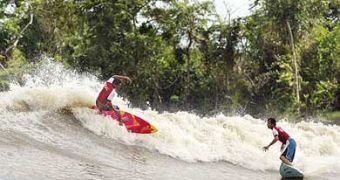
 14 DAY TRIAL //
14 DAY TRIAL // 
